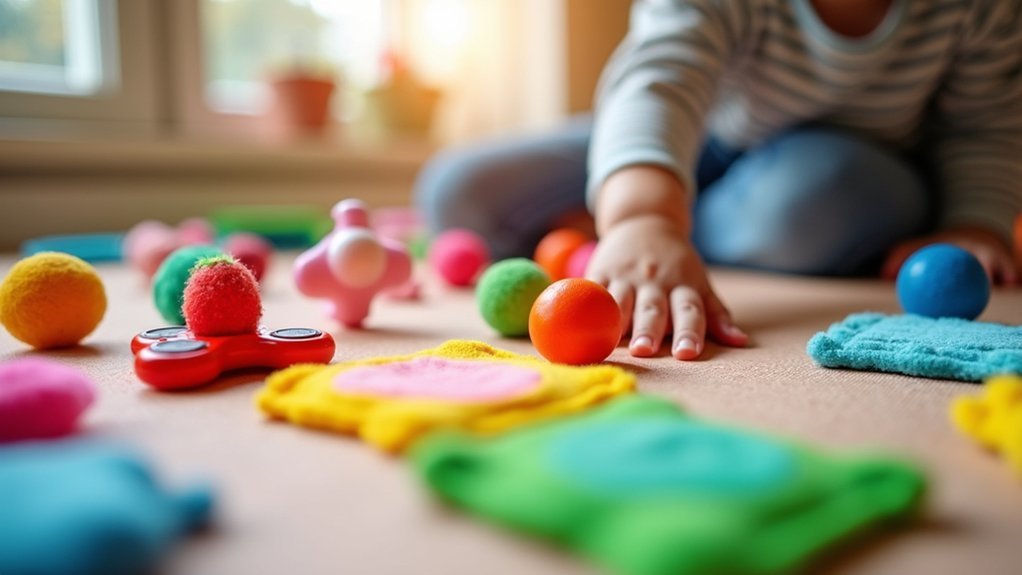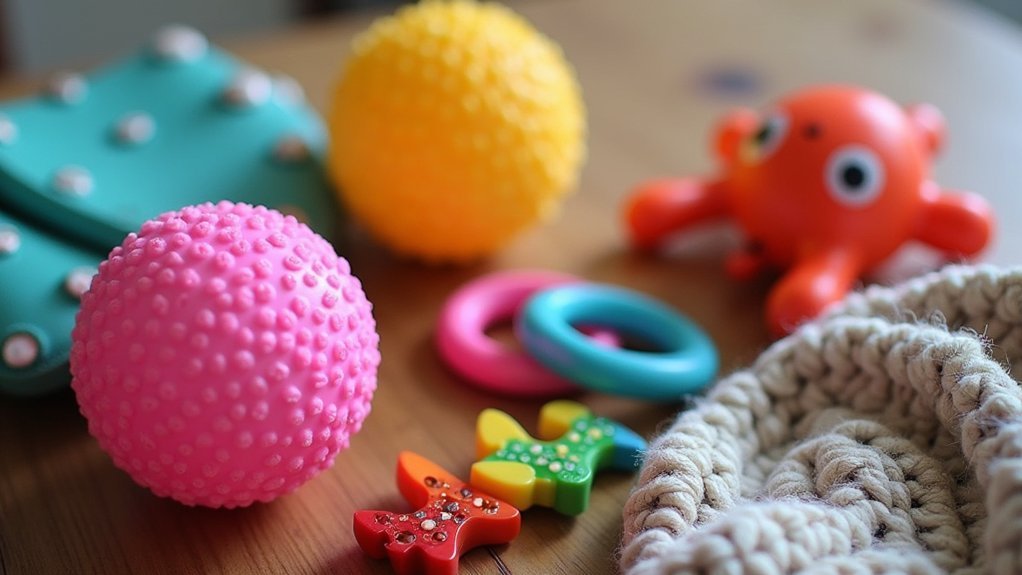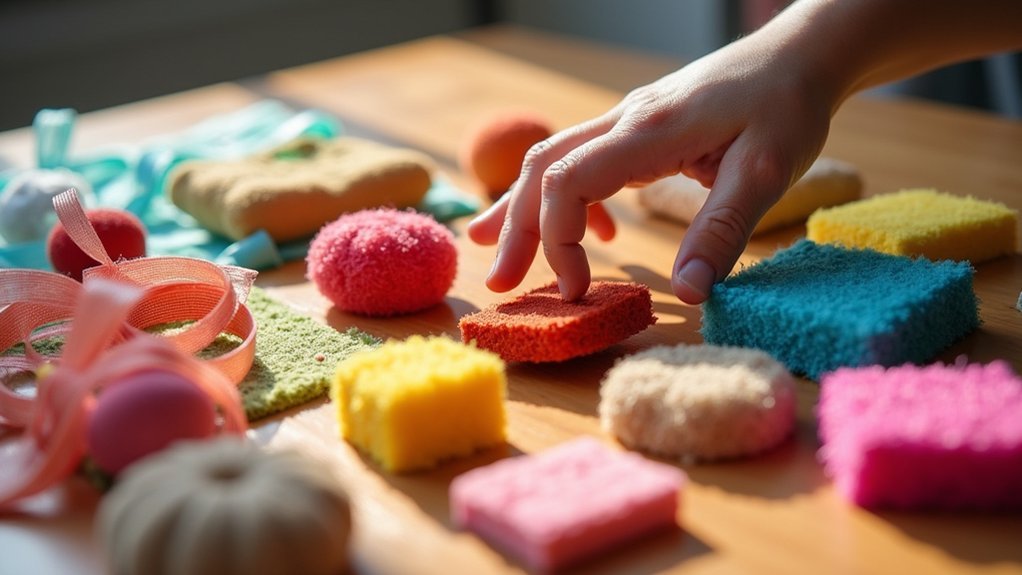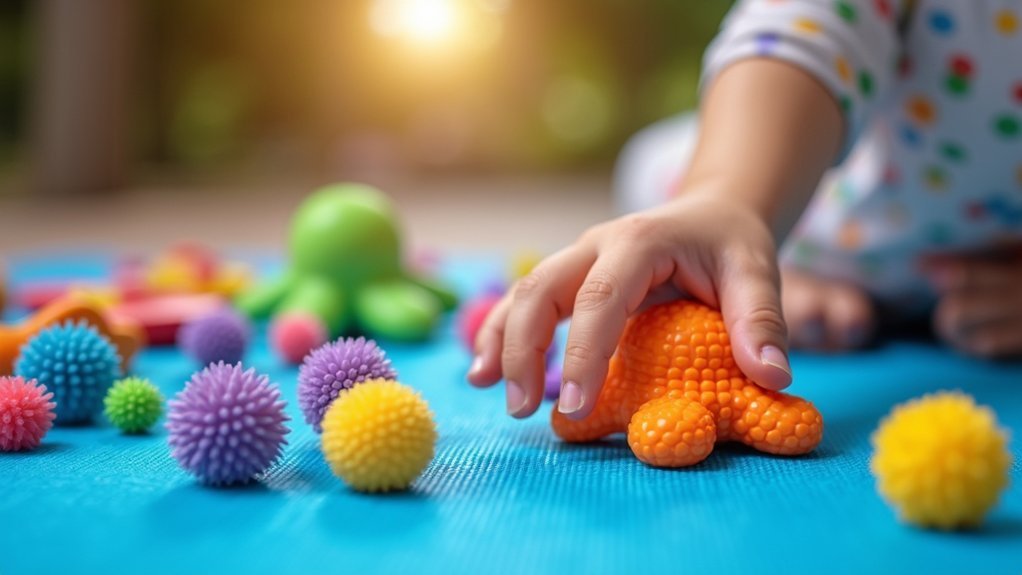Tactile tools like Wilbarger therapy brushes, weighted blankets, and fidget devices provide essential sensory input for special needs children. You’ll find compression garments and chewable tools particularly helpful for anxiety reduction and self-regulation. Sensory bins filled with rice or beans encourage fine motor development, while therapy balls improve balance and coordination. Textured materials and wobble cushions offer deep pressure input that transforms challenging behaviors. Explore these options to discover which sensory supports best match your child’s unique developmental profile.
Essential Tactile Stimulation Toys for Sensory Processing Support

When children with special needs struggle to process sensory information from their environment, tactile stimulation toys can provide essential support for their development.
Wilbarger therapy brushes and weighted lap pads deliver calming sensory input that helps regulate a child’s nervous system and enhance their awareness of touch sensations.
Textured tools like Tangle Jr. and sensory spaghetti encourage exploration of different surfaces while simultaneously developing fine motor skills.
For children seeking movement input, therapy balls and rolls promote balance, coordination, and body awareness—critical skills for those with sensory processing disorders.
Don’t overlook oral sensory needs; products like Chew Stixx Tough Bar offer safe chewing options that satisfy oral stimulation requirements.
Sensory activity tables with sand or water create multi-sensory experiences that support tactile development through creative play.
Weighted and Compression Tools for Calming Sensory Experiences
Deep pressure therapy stands at the forefront of sensory regulation strategies for children with special needs. Weighted blankets and vests deliver consistent pressure input that reduces anxiety and promotes calm in children with sensory processing challenges.
Deep pressure interventions provide essential sensory input that grounds children, creating a foundation for emotional stability and functional learning.
You’ll find that compression garments offer similar benefits, providing gentle pressure that enhances body awareness and helps children with autism better regulate their emotions and responses.
For classroom settings, weighted lap pads are particularly effective tools, allowing children to remain focused during activities without disrupting their learning environment.
These tactile tools work by influencing key neurotransmitters—increasing serotonin and melatonin while decreasing cortisol levels.
Fidget Devices That Improve Focus and Regulation

Unlike traditional classroom tools, fidget devices offer specialized tactile input that can transform learning experiences for special needs children.
These tools provide essential sensory stimulation that helps children with ADHD and autism manage their sensory input and extend their attention spans during learning activities.
You’ll find options like textured fidget toys and wobble cushions deliver deep pressure input that reduces anxiety while promoting a sense of security.
The Sensory Genius Fun & Focus Pack exemplifies how varied tactile options cater to different sensory preferences through hands-on interaction.
Oral Motor Tools for Sensory Seekers
Your child’s sensory-seeking behavior may manifest through chewing, requiring specialized tools like Chewelry and Chew Stixx Tough Bar to provide necessary oral regulation.
You’ll find these oral motor solutions can transform challenging behaviors into productive sensory integration while allowing discreet use during classroom activities.
Incorporating a variety of textures through both specialized tools and strategic snack choices helps meet your child’s proprioceptive needs, ultimately enhancing their focus and communication skills.
Chew-Friendly Sensory Solutions
For children who constantly seek oral sensory input, chew-friendly tools provide a safe and effective way to meet their needs. Products like Chewelry and Chew Stixx Tough Bars offer appropriate proprioceptive input while being made from non-toxic, durable materials that won’t damage teeth.
You’ll find these chew-friendly sensory solutions particularly helpful during challenging activities when your child needs self-regulation support. They’re designed to reduce anxiety and enhance focus by delivering calming oral stimulation when sensory experiences might otherwise overwhelm your child.
Incorporating these tools into daily routines isn’t just about satisfying the urge to chew—it actively supports your child’s development by improving oral sensory processing and fine motor skills.
For special needs children who seek oral input, these solutions provide the sensory regulation they need to thrive.
Oral Textures Matter
When it comes to oral sensory needs, texture variations play a significant role in how children respond to and benefit from sensory tools.
You’ll find that offering a diverse range of textures—from soft to firm, smooth to bumpy—helps children discover which oral motor experiences best meet their sensory requirements.
Incorporate chewable jewelry that provides necessary proprioceptive input while remaining socially appropriate.
For dietary options, alternate between crunchy pretzels and chewy gummy treats to fulfill oral cravings while developing fine motor skills through varied chewing patterns.
You’ll notice improved focus and classroom engagement when you integrate these oral motor tools into daily routines.
Textured Materials That Enhance Tactile Discrimination

Exploring a wide variety of textured materials provides essential sensory input for special needs children who struggle with tactile discrimination. You’ll find that incorporating textured materials like sensory mats, fabric swatches, and sandpaper helps your child differentiate between surfaces while developing finer sensory awareness.
| Material Type | Benefits | Activity Ideas |
|---|---|---|
| Sensory Bins | Promotes exploration | Fill with rice, beans or pasta |
| Textured Balls | Improves grip | Rolling and catching games |
| Fabric Swatches | Enhances discrimination | Matching and sorting challenges |
Research shows these tactile experiences support children with autism in developing better sensory processing. Try structured activities using resources like Tangle Jr. or Sensory Spaghetti, which encourage your child to identify differences through touch, simultaneously supporting cognitive and physical development.
Proprioceptive Equipment for Body Awareness Development
Proprioceptive equipment adds another dimension to tactile learning by focusing specifically on body awareness development. When you introduce these tools to special needs children, you’re helping them gain better spatial awareness and self-regulation skills.
- Weighted blankets and vests provide calming deep pressure input that improves body awareness and helps children organize sensory information.
- Heavy work activities using therapy balls or carrying weighted baskets enhance proprioceptive feedback and develop body control.
- Wobble cushions and sensory swings encourage movement and balance, improving classroom focus while developing essential proprioceptive senses.
- Resistance bands and therapy rolls can be incorporated into daily routines to reduce anxiety and improve attention spans while fostering independence.
These proprioceptive equipment options create meaningful sensory experiences that transform how special needs children interact with their environment.
Multi-Sensory Bins and Activities for Exploration
Multi-sensory bins filled with rice, sand, or water beads offer special needs children essential texture variety that can gradually improve their sensory processing and fine motor skills.
You’ll find creating DIY bins surprisingly simple—use themed materials like ocean elements or seasonal items in plastic containers to engage children’s imagination while addressing specific sensory needs.
When guiding exploration, start with preferred textures before introducing challenging ones, and model interactions by demonstrating scooping, pouring, and searching for hidden objects to encourage meaningful engagement.
Texture Variety Benefits
When children with special needs interact with a diverse range of textures, they open up a world of sensory experiences that can greatly enhance their development.
Offering various tactile materials within sensory bins can help a child strengthen fine motor skills while simultaneously providing therapeutic benefits.
The advantages of texture variety include:
- Enhanced sensory awareness – Children develop better understanding of their environment through touch exploration
- Improved focus and attention – Textural engagement often has calming effects that promote concentration
- Strengthened hand muscles – Manipulating different materials builds dexterity and grip strength
- Developed social skills – Collaborative texture play encourages sharing, turn-taking, and communication
You’ll notice that as children explore these varied textures, they’re not just playing—they’re building essential developmental skills through enjoyable sensory experiences.
DIY Sensory Bin Ideas
Creating your own sensory bins at home offers a cost-effective way to provide rich tactile experiences for children with special needs. Start with a shallow container filled with base materials like rice, beans, or water beads that engage different tactile sensations.
Enhance the experience by adding small toys, scoops, and containers that encourage fine motor development and imaginative play. Natural elements such as leaves, rocks, or pinecones bring outdoor exploration indoors while providing diverse textures.
Consider developing themed bins—like ocean or farm settings—to teach concepts while offering calming activities for children with sensory processing challenges.
The beauty of DIY bins lies in their adaptability; rotating contents regularly keeps exploration fresh and engaging, fostering problem-solving skills and creativity through hands-on discovery.
Guided Exploration Techniques
While DIY sensory bins provide excellent materials, effective guided exploration transforms these tactile tools into powerful learning opportunities. When guiding special needs children through multi-sensory experiences, your approach can greatly enhance their development and engagement.
- Start with observation – Watch how the child naturally interacts with the sensory bin before introducing guided techniques.
- Use assistive technology – Integrate switches or adaptive tools that allow children with motor challenges to independently manipulate bin contents.
- Implement turn-taking activities – Encourage social skills by structuring exploration that requires sharing and cooperation.
- Provide verbal scaffolding – Narrate actions and ask open-ended questions that promote language development and problem-solving.
These guided exploration techniques transform sensory bins from simple play into structured learning experiences that address specific developmental needs while maintaining the joy of discovery.
Adaptive Tactile Tools for Different Ability Levels
Children with special needs often require customized sensory solutions that match their unique developmental profiles. Adaptive tactile tools, like Wilbarger therapy brushes, provide targeted sensory input that enhances sensory awareness and integration skills, making them ideal for children with processing disorders.
For children with autism, weighted blankets and vests deliver deep pressure input that promotes calmness during stressful situations. Sensory mats with varied textures encourage exploration and fine motor skill development by stimulating touch and proprioception.
You’ll find fidget toys like the Textured Tangle Jr. help maintain focus during learning activities by giving restless hands a tactile outlet.
Meanwhile, therapy balls and rolls improve balance and coordination while promoting movement, making them suitable for children with diverse physical abilities.
Frequently Asked Questions
What Are Tactile Objects for Autism?
Tactile objects for autism include fidget toys, sensory mats, therapy putty, weighted blankets, and chewable jewelry. You’ll find these tools provide sensory input that helps improve focus, reduce anxiety, and support self-regulation.
What Are Sensory Tools for Autistic Kids?
Sensory tools for autistic kids include weighted blankets, Wilbarger therapy brushes, fidget toys, chewelry, sensory tables, and tactile bins. You’ll find they provide calming deep pressure input and support sensory regulation for your child.
What Is Sensory Stimulation for Special Needs?
Sensory stimulation for special needs involves activities that engage your child’s senses to improve development. You’ll find it helps with self-regulation, focus, and communication while reducing anxiety and challenging behaviors through targeted sensory experiences.
What Are Tactile Tools?
Tactile tools are specialized equipment you’ll use to provide touch-based sensory input. They’re designed to stimulate your sense of touch through different textures, pressures, and surfaces, enhancing sensory processing and engagement.
In Summary
When you’re supporting a special needs child, you’ll discover that the right tactile tools can transform their sensory experience and development. Whether you’re introducing weighted blankets, fidget spinners, chewable pendants, or textured mats, you’re providing pathways to self-regulation and learning. Remember, it’s not about the tools themselves but how they’ll help your child connect with their world in a way that works for their unique sensory profile.





Leave a Reply